|
|
| Several RC magazines around the world have asked us to write a monthly column. With the kind permission we will re-publish the column at our web site too so all of the XRAY fans can read the latest news and behind the scenes information. Enjoy. |
|
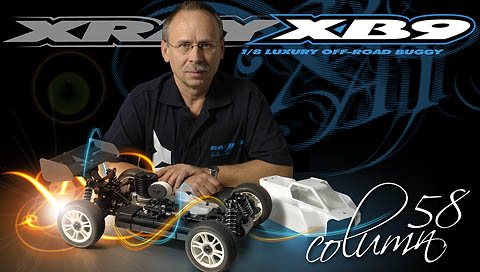
Juraj Hudy and the all-new XB9 project
(click to enlarge) |
|
|
|
| XRAY entered the world of dust and dirt with the first XB8 back in 2004, followed with a completely new and updated 808 platform in 2008. Since the very first days in the off-road world we have enjoyed some great times but also faced many challenges. Over the years we put together a very stable and professional team but in the âśpeakâś years we also experienced some unexpected moves and shifts from team drivers who were blinded by unrealistic promises flying around. Over the years we have enjoyed some great results including achieving European Championship titles, and we were also very close to grabbing the World Championship title in Jakarta. And mixed in with some great race results and achievements, we have also experienced the âśflip sideâť at major races where none of the team drivers made it to the main finals. Weâ™ve ridden all these ups and downs for years and we have always continued to work on further car development and improvements regardless of current results or the situation in the market which has seen some excessive moments. |
|
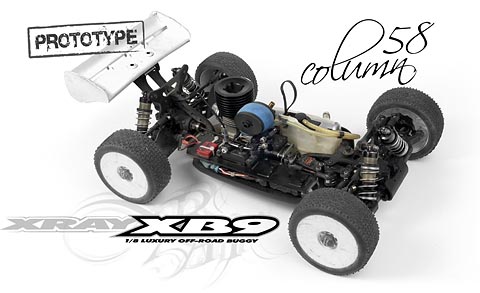
One of the first prototypes, notice the radio tray
(click to enlarge) |
|
|
|
| The off-road market has recently experienced the highest boom world wide, and has been the most popular as well as the most competitive category. Everyone has noticed that in a certain period we would see new companies and the same re-branded products almost every week, and we would experience some major moves between teams⦠but at the same time we have seen many companies coming wink in and out of existence. Regardless of the times, we have kept to what we are best at: hard work. I am now back in full power with my both R&D and racing team in the off-road category and you may expect some great stuff coming! Itâ™s time to flip the pages of history; itâ™s time to create a new future. Itâ™s time for the XB9. |
|
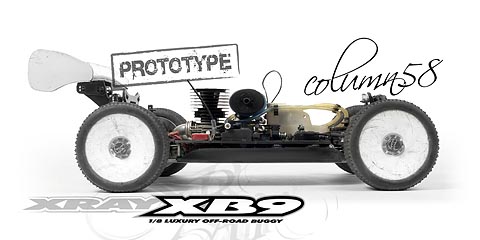
Side view of the first XB9 prototype
(click to enlarge) |
|
|
|
We started working on the all-new platform a year ago and as usual with all our other projects we have taken in all the comments, feedback, and reports collected from the team drivers, distributors, dealers and of course customers. Every single feedback received has been recorded and when it was the proper time we went through all of them and analyzed them. Of course it is impossible to incorporate ALL the details and requirements because some ideas will work in some specific conditions but would not work in others. As such it is very important to find the best compromise and balance between all the details to make a car that works well in all conditions and has sufficient set-up options to fine-tune the car for specific tracks. The same strategy has to be considered when specifying the materials as some materials will work great in hot conditions but would not work in cold and vice-versa. It is all about finding the optimum compromise.
This time I will start from the very end⦠|
|
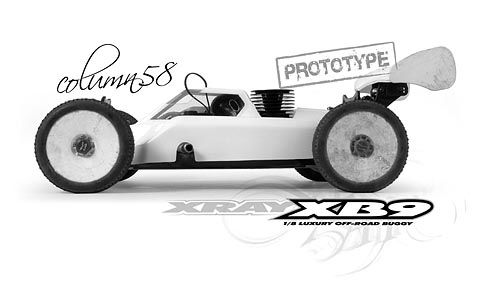
First body prototype
(click to enlarge) |
|
|
|
| The last part of the design we worked on very actively was the body and wing. Together with the car and tires, the body and wing have significant influence on the handling of the car and since the competition level has increased lately, it was time for an all-new body and wing. The 808 body and wing were designed to be neutral so they worked for all track conditions. The correct body and wing are now part of the set-up changes made for specific track conditions, the same as with the on-road category where the body has significant influence on performance and handling. With this in mind I logically decided that we would need to have more and different bodies to allow drivers to adjust based on the track. |
|
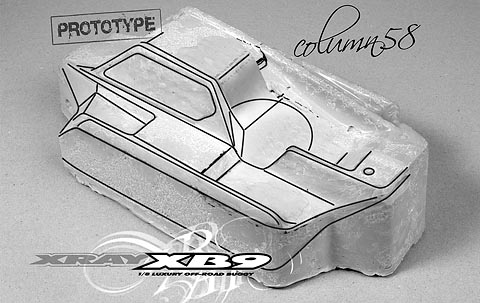
Modifying the first prototype mould clay
(click to enlarge) |
|
|
|
| The first design idea was to make a body for smooth and fast tracks with high downforce and side guiding to make the car stable on jumps and in fast parts. Big emphasis was put on the engine area to allow enough air to reach the engine for sufficient cooling. For downforce I oriented things to concentrate downforce in front and middle of the body, while rear downforce is generated by the all-new rear wing. After extensive work with my designers, we came forward with some great 3D models. After I had the âśvirtualâśconcept and idea, I needed to make a real 3D model from clay to have the feeling of every small detail. It took me several days to get the clay model where I wanted it to be. Using this clay model, we made a production mould and then punched out some of the first prototypes. |
|
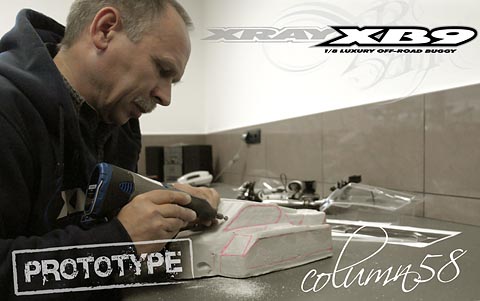
All mould clay modifications were first hand-made
(click to enlarge) |
|
|
|
| Meanwhile, back in the computer, we prepared several different versions of the wing. I have discussed all the different versions with the team, especially with Reno who originally put in some of his own ideas into the wing design. Sharing CAD files via electronic transfer is now incredibly fast and effective, and allows remote teams to work and collaborate from anywhere in the world. The input from the team has been very useful and pushed development even further. After we selected the final favorite designs, using fast prototype technology we produced a few prototypes for real track testing together with the new body⦠and of course besides me the new parts were tested by the team as well. The test results of the wing were extremely good but the results of the body were disappointing; the new body had too much downforce. The car was excellent in the air but on a bumpy track the downforce was so excessive that the car was following every small bump or hole which made it more difficult to handle. Well, the negative experience is also a good experience as it builds new knowledge so the next time you do not make the same mistakes. |
|
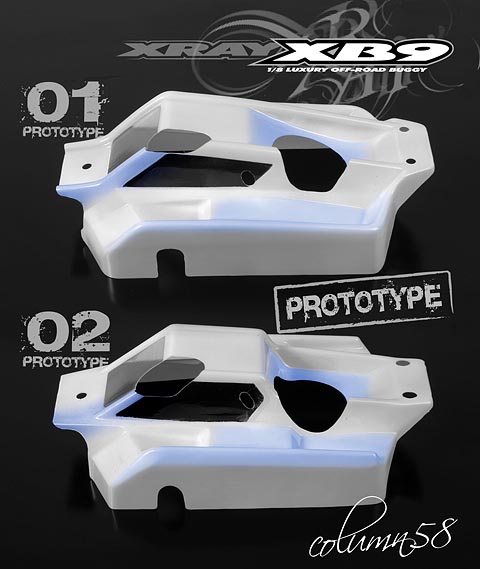
Comparison of the body prototypes in version 01 and 02, see the light blue areas
(click to enlarge) |
|
|
|
| After the initial negative experience of the first body design I went back to the clay mould and reworked it significantly all around. Every day I thought the design was now great and could be finalized, but the next morning I again found something still not perfect or I had a different idea to try which I usually got in the night when I was re-analyzing all the details in my brain - many times while sleeping but many times when I could not sleep. After a few days of this I decided that I just needed to stop and put the design into the real production mould stage. After the new bodies were produced and tested, the team and I were finally satisfied as the combination of the new wing and body really worked well. Now I am really looking forward to real race tests next week in Padova (Italy) where the first pre-production XB9 will be fully tested by the team. I am again very nervous like I always am when the final design is finished and needs to be tested under real race conditions which are always a bit different than private or local race testing. |
|
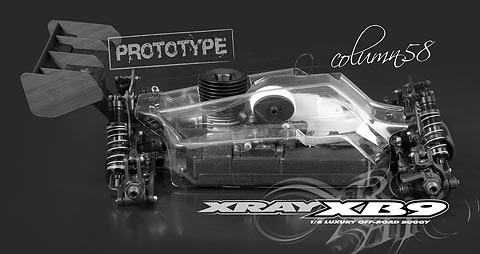
The first prototype body, see the straight lines
(click to enlarge) |
|
|
|
| But letâ™s go back to the beginning. High-competition cars in any class have undergone dozens of years of development, and so most of them look very similar or the same at first glance. However, it is in the small details of design, construction, and especially materials and quality that the differences lie. As such our strategy was very easy: we were not going to re-invent the wheel but rather we will build on what was good in the XB8 and 808 platforms, and improve all the areas which during the years we have learned and experienced would need some changes. |
|
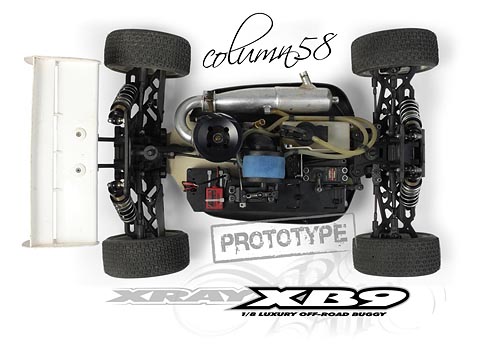
Top view on the XB9 prototype using most of the 808 parts
(click to enlarge) |
|
|
|
The main areas we have focused on making the XB9 a next-level platform were:
⢠Improved reliability
⢠Improved balance both on the track and in jumping
⢠Improved traction and stability on the track
The first balance tests were made already in the standard 808 car. We produced several different radio trays which allowed us to mount either the batteries or different additional weights wherever we needed/ wanted to test, and also allowed us to use either standard or lightweight LiPo batteries. All of the best results were achieved when we used LiPo batteries and 60 grams weight behind the front suspension; this seemed to be the optimum balance to start working with. |
|
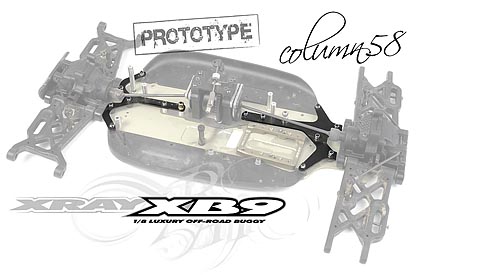
Some non-typical reinforcement plates
(click to enlarge) |
|
|
|
| To gain more traction we focused on major areas ⓠchanges in geometry, change in shock construction, and changes in flex of the chassis. The proper combination of all these points is crucial for the car to generate the appropriate traction. I started with the part which I am convinced has the most significant influence on the car: the flex of the chassis. Having a lot of experience from the on-road category where chassis flex is absolutely key to the best performance, I had a clear idea of the direction the design should head. I started with an all new chassis layout, made it very narrow and straight in the longitudinal direction (meaning the width of the chassis is the same from front to the rear). This design was a first major step forward, and it noticeably generated more traction. Based on our excellent results with the Multi-Flex™ innovation and design used in XRAY on-road cars, I simply needed to incorporate it into the off-road car. I am more than convinced that this tuning possibility will be extremely useful and effective for an off-road car too. I have been carrying this idea for a long time and now was the perfect opportunity to make it happen. |
|
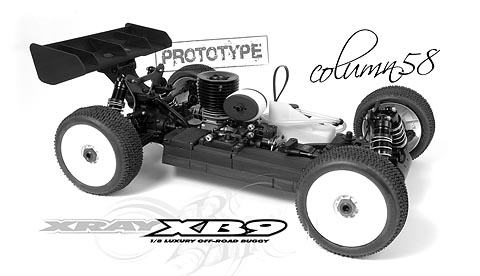
Rapid prototype battery tray
(click to enlarge) |
|
|
|
| The XB9 Multi-Flex™ is very easy and smart at the same time, and of course very effective. Using special reinforcement braces mounted with stands in longitudinal direction and other ones in later direction allows you to increase or decrease the chassis flex and as such directly affect the traction. These Multi-Flex™ braces were designed and produced for both front and rear of the car to allow different tests to give more knowledge and experience. The long term tests confirmed my expectations: the Multi-Flex™ works really well! The negative aspect was more complicated access to the parts for servicing and cleaning, and these stands also took up more space than necessary. As such for the final design I came up with an idea to re-design the radio box and side guards to allow easier set-up of the Multi-Flex™. |
|
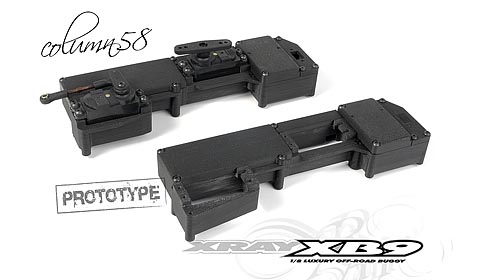
First and second version of the rapid prototype radio tray
(click to enlarge) |
|
|
|
| Both the radio box and side guards were designed to be stiff, but by removing the screws from the bottom the flex increases. We quickly produced a couple of fast prototype samples for further testing. I was satisfied with the results on the radio box side but the left side was not to my likeness and we had to return to the e-drawing board. |
|
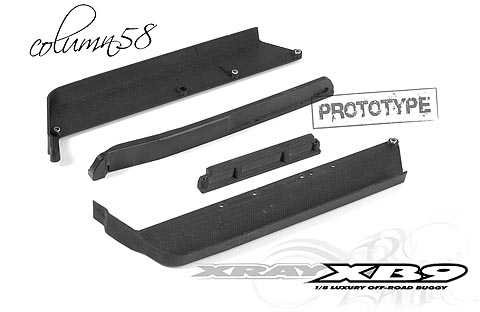
First version of the Multi-Flex side guards with independent brace
(click to enlarge) |
|
|
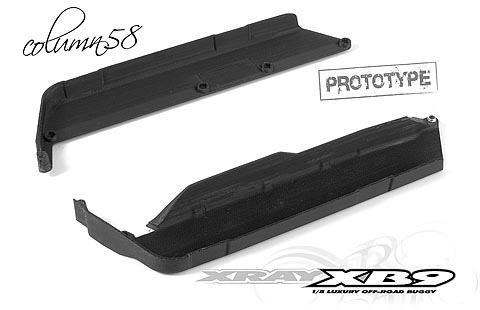
Second version of the Multi-Flex side guards with integrated brace
(click to enlarge) |
|
|
|
| We needed to make the left side guard even stiffer and as such I have incorporated a large brace between the muffler and fuel tank and added more screws. I also used the already existing brace and made it as a kind of fuel tank protector from the muffler while at the same time it is an isolator that prevents the heat from the muffler from warming the fuel. While testing I even used extra insulating tape on the protector which increased the heat protection. After another few weeks of testing the new prototypes, we were all finally happy and satisfied with how the Multi-Flex™ worked. I am confident that regular drivers and customers will appreciate and really like and use this new and innovative feature. |
|
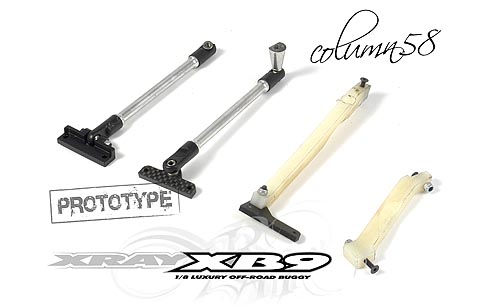
Some very first front and rear chassis brace prototypes
(click to enlarge) |
|
|
|
| Chassis flex in off-road is influenced by the chassis itself and both front & rear braces. To get the final design of the chassis we had to make a few dozen different designs and layouts which all were tested and compared. It was all about finding the best compromise between stiffness (for stability) and flex (for traction). Too much traction is not good as the car âśparksâśin the corner and the dynamics suffer. So it is all about the alchemy of mixing the details in the proper way. Just to test all the different braces took a few dozen different designs: from long to short, from extended to ultra-short and strong, and of course using different materials from soft to medium to ultra-hard. In the front I could utilize the front upper plate which we could use to set-up the stiffness. |
|
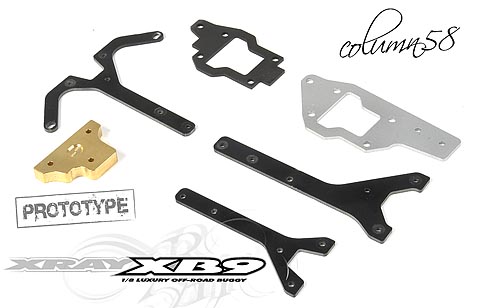
Some of the very first chassis reinforcements including additional weight brace to test the balance
(click to enlarge) |
|
|
|
| Using aluminum bushings we connected the upper plate to the chassis along the axis, which greatly reinforced the chassis and at some particular tracks this has worked perfectly as it helped the steering to be more precise⦠but then on smooth tracks the steering decreased. The funny thing is that after extensive work both behind computer screen and on the tracks and testing all the different braces, we returned back to the standard braces already being used on previous cars, as these give the best compromise suitable for most standard conditions. But the option to reinforce the braces with additional bushings has worked well and we will probably include it in the final kit to give customers additional tuning options. |
|
|
| I will soon be leaving for Italy to the Padova race, and since I just received some last pre-production parts I need to end the first part of the column here and get back to work to finish the build of the XB9. I will get back to you with more details in the next column. |
|

|
See you around the tracks!
Enjoy the ride and â�til next time,
Dipl. Eng. Juraj Hudy
XRAY Chief Designer |
| Archive: |
|
Column #1 - Behind the Scene Stories
Column #2 - Worlds Flashback
Column #3 - T2'007 Debut
Column #4 - Designing the T2'007
Column #5 - Worldcup Review and NT1 Testing
Column #6 - Developing and Designing the NT1
Column #7 - Developing and Designing the NT1 - Part 2
Column #8 - Back to the Races
Column #9 - XT8 Truggy Development
Column #10 - Touring Car Development
Column #11 - Bling-bling Mentality
Column #12 - Hot Summer Washout
Column #13 - New Electric Touring Car
Column #14 - Off-road Development
Column #15 - My micro love
Column #16 - Back in the Dirt
Column #17 - Worlds Preparations
Column #18 - 808 Tests & Stress
Column #19 - Excited for the Worlds?
Column #20 - Statistics, Expenses Sheets, Production Analysis, Calculationsâ¦
Column #21 + Column #22 - Euros + Euros + Worlds
Column #23 - The Busiest Season Ever
Column #24 - In Between the Worlds
Column #25 + Column #26 - Well Developed or Overdeveloped?
Column #27 - Back to The Future
Column #28 - 2009 Kick-off
Column #29 - Crazy what?
Column #30 - Last indoor race of the season
Column #31 - Getting into summer season
Column #32 - Heading for the Euros
Column #33 - Testing - Always last minute, always new ideas
Column #34 - European Champion - title celebration
Column #35 - Time to move on
Column #36 - National Heroes
Column #37 - 2010 ready
Column #38 - Decade of Triumph
Column #39 - 2010 Racing Calendar
Column #40 - DHI, ETS & NĂĽrnberg Show
Column #41 - World Championship Practice
Column #42 - EC indoor, EC 1/12, Silverstate, LRP Masters, Neo
Column #43 - Nationals All Around
Column #44 - Warm Warm-ups, Challenging Challenges
Column #45 - Electric Touring Worlds 2010
Column #46 - Team XRAY - World Champion!!!
Column #47 - Summer Vacation, 30x USA Champion Title
Column #48 - T3 Saga Continues
Column #49 - RX8 â“ What? How? When?
Column #50 - The Making of the RX8 â“ Part II
Column #51 - Shake It, Baby, Shake It...
Column #52 - Racing Season â�11 Full Running
Column #53 - From On-road to Off-road
Column #54 - Testing and Once Again⦠Testing
Column #55 - Half of the EC Championships â“ Done!
Column #56 - Summer is Goneâ¦Euros are Done
Column #57 - Never-ending Development |
|























